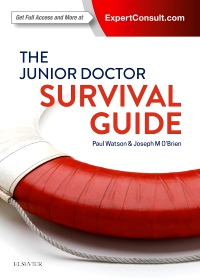
The Junior Doctor Survival Guide - E-Book, 1st Edition
Elsevier eBook on VitalSource

Now $38.94
Be punctual, hard-working and honest, but most importantly – be excellent.
Written by residents, for interns and residents, the Junior Doctor Survival Guide is a thorough, focused summary of everything you need to know to get through your internship and residency (relatively) intact.
It provides advice on seeking help from your senior clinicians, ensuring ethical practice and decision making, conducting an efficient ward round and carrying out emergency assessments and includes a concise overview of the salient features of specialist medical and surgical care in both in- and outpatient settings.
Covering both clinical and professional contexts, this guide will support you to build your confidence in applying the principles you learned in medical school to the real world.
-
- Scenario boxes – how difficult conversations should be approached
- Common medications – quick reference tables of common medications and dosages
- Clinical abbreviations and acronyms – a comprehensive list of common abbreviations and acronyms used throughout clinical settings
-
Section I: General information
Chapter 1: Welcome to medical practice
Chapter 2: The junior doctor
Chapter 3: Careers
Chapter 4: Professionalism
Chapter 5: Communication
Chapter 6: Teaching and education
Chapter 7: Representation of Junior Doctors
Chapter 8: FinancesSection II: Initial Assessments
Chapter 9: The emergency department
Chapter 10: Critical care assessments
Chapter 11: Initial assessment of patients: history and examination
Chapter 12: Investigations: serology
Chapter 13: Investigations: other pathology
Chapter 14: Investigations: imaging
Chapter 15: Making referrals
Chapter 16: Admissions
Chapter 17: Clinical procedures
Chapter 18: The patient with mental illness
Chapter 19: Forensic medicine
Chapter 20: Notifiable diseasesSection III: The Ward
Chapter 21: The inpatient ward
Chapter 22: Ward rounds
Chapter 23: Inpatient prescribing
Chapter 24: Managing fluids and infusions
Chapter 26: The dying patient
Chapter 27: The deceased patient
Chapter 28: The preoperative patient
Chapter 29: The operating theatre
Chapter 30: The postoperative patient
Chapter 31: Inpatient discharges
Chapter 32: Allied health and clinical support staff
Chapter 33: Unit meetingsSection IV: Medical and surgical specialties
Chapter 34: General medicine
Chapter 35: Cardiology
Chapter 36: Respiratory medicine
Chapter 37: Gastroenterology
Chapter 38: Renal medicine
Chapter 39: Endocrinology
Chapter 40: Neurology
Chapter 41: Infectious Diseases
Chapter 42: Medical oncology
Chapter 43: Haematology
Chapter 44: Rheumatology
Chapter 45: General Surgery
Chapter 46: Orthopaedic Surgery
Chapter 47: Vascular Surgery
Chapter 48: Cardiothoracic Surgery
Chapter 49: Ear, nose and throat (ENT) and head and neck surgery
Chapter 50: Neurosurgery
Chapter 51: Plastic and reconstructive surgery
Chapter 52: UrologySection V: Outpatients
Chapter 53: Pre-admission clinic
Chapter 54: Informed Consent
Chapter 55: Medical outpatient clinics
Chapter 56: Cardiology outpatients
Chapter 57: Respiratory outpatients
Chapter 58: Gastroenterology outpatients
Chapter 59: Renal outpatients
Chapter 60: Endocrine outpatients
Chapter 61: Neurology outpatients
Chapter 62: Medical oncology outpatients
Chapter 63: Haematology outpatients
Chapter 64: Rheumatology outpatients
Chapter 65: Surgical clinics
Chapter 66: General Surgery outpatients
Chapter 67: Orthopaedic outpatients
Chapter 68: Vascular outpatients
Chapter 69: Cardiothoracic outpatients
Chapter 70: Ear, nose and throat and head and neck outpatients
Chapter 71: Neurosurgery outpatients
Chapter 72: Plastic and reconstructive surgery outpatients
Chapter 73: Urology outpatientsSection VI: Appendices
Appendix I: Common Medications
Appendix II: Normal Lab values
Appendix III: Microbiology
Appendix IV: Antibiotics

 as described in our
as described in our 